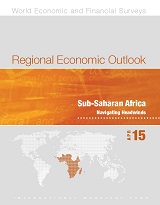Sub-Saharan Africa
Regional Economic Outlook: Navigating Headwinds: Sub-Saharan Africa
April 2015
[$token_name="PublicationDisclaimer"]

Sub-Saharan Africa’s economy is set to register another year of solid growth, although the expansion will be at the lower end of the range registered in recent years, mainly reflecting the severe impact of the sharp decline in oil prices on the region’s oil exporters. In a context of tightening global financial conditions, the large fiscal and current account deficits that prevail in some countries could leave them vulnerable to a potential reduction in external financing. An uneven global recovery and domestic security-related challenges are also risks to the outlook. Against this backdrop, and beyond the immediate effects of the current shock, further progress toward diversification and structural transformation remains crucial to sustain high and inclusive growth, generate jobs for the rapidly growing young population, and foster integration into global value chains.
Contents
Front Matter
Chapter 1: Navigating Headwinds
Sub-Saharan Africa’s economy looks set to register
another year of solid growth in 2015 (4½ percent).
Still, this expansion will be at the lower end of the
range by recent standards, and reflects the adverse
shock that has hit some of the region’s largest economies
due to the sharp decline in oil prices. The
impact of this shock is set to be quite heterogeneous:
for the eight oil exporters, it will pose a formidable
challenge and, with limited buffers, will require them
to undertake significant fiscal adjustment. For most
other countries, lower oil prices represent a favorable
development which, however, will be partly offset in
some cases by lower prices of other commodities that
they export. Read more...
- Global Backdrop: Not What It Has Been
- Outlook: Growing (with) Pain
- Falling Commodity Prices: A Tale of Two Africas
- External Financing Conditions: The Times They Are A-Changin'?
- The Impact of the Ebola Outbreak
Chapter 2: How Can Sub-Saharan Africa Harness the Demographic Dividend?
By 2035, the number of sub-Saharan Africans
reaching working age (15–64) will exceed that
of the rest of the world combined. This
is a trend with potentially significant implications for
both the region and the global economy.
- Sub-Saharan Africa’s Demographic Transition
- The Demographic Dividend: Channels and Challenges
- The Demographic Dividend: International Experiences
- Policy Options for Sub-Saharan Africa
- Policy Scenarios
- Conclusions
Chapter 3: Global Value Chains: Where are You? The Missing Link in Sub-Saharan Africa's Trade Integration
This chapter reviews the extent and strength of integration
of sub-Saharan Africa into the global economy,
with a special focus on trade and participation in
global value chains. It evaluates how trade integration
has contributed to economic performance in recent
decades. Looking ahead, it examines the factors likely
to allow the region to tap its still substantial trade
integration potential, in particular through better positioning
in global and regional value chains to support
durable growth and foster structural transformation.
- International and Regional Integration Over the Last 20 Years
- Trade Openness and Macroeconomic Performance
- What Can Support Further Integration into Global Value Chains?
- Conclusions
- Annex 3.1. Recent Trends in Regional Financial Integration in Sub-Saharan Africa
- Annex 3.2. Description of Econometric Models Used and List of Country Groups


